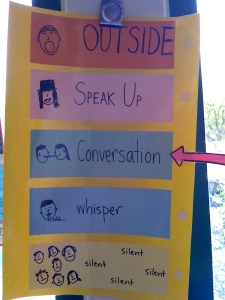
Hannah and her former co-teacher Mansi in Brooklyn, NY. Co-teaching can lead to lasting friendships based in shared values and experiences. (including happy hour!)
I feel lucky to say that the past 5 years spent in the classroom have been spent along side a coach, mentor, role model, confidant and friend. Oh, and a co-teacher.
The often-heard comparison to co-teaching is that it’s “like a marriage.” Given the day and age this is clearly a weighty analogy, but the things that make a successful teaching partnership are the same as those of any relationship: commitment and communication.
Well, isn’t that nice. This may be true, but the difference is that while many people are lucky enough to have the opportunity to “test the waters” of their relationship, many co-teachers are thrown in to a classroom together, given a few days to get settled, and are told, “good luck! Have a great year!”
So, never mind that old analogy. Keeping in mind the tenets of commitment and communication, here’s what we’ve learned about making it work in a co-teaching relationship.
1. Find out the best way the two of you communicate and use it. Does he prefer texts? Will she answer emails quickly but would prefer to keep phone usage personal? Either is great, but as a co-teacher, you probably will need to get used to a little outside of the school day communication.
2. With that in mind, be respectful. Show up on time to work, run a sick or personal day by your co-teacher before the day of, even if you get a sub. Do at least your fair share of work, and sometimes do more. Refrain from texting in the middle of the night or sending an urgent email Sunday evening.
3. Back each other up. Many co-teaching relationships fail because of a good-cop/bad cop situation in the classroom. If you don’t agree with how something was handled, address the issue after class. (But be sure to address it! We will cover how to have those conversations later.)
4. Ask questions. This is the counter to the control-freak nature so many of us have hard-wired, but it still allows us to have our opinions heard. “What do you like to do for a morning routine?” “How do you record assessment data?” “Do you like to work through lunch?” “What does a hard-working classroom look and sound like to you?” Practice.
5. Get with it. Learn how to use Google Docs, Drive, and Dropbox. Be sure you know how to make an Excel spreadsheet and a table in Word. (Even if your school provides some planning program or you are addicted to your spiral planner.) Spiral planners don’t allow you to update in real time together when you’re apart, and most school-provided programs are too clunky to successfully share files. These things were made for the professional world we live in, and we are professionals!
6. Get emotional. Yes, the first time your co-teacher lets you down, you’ll get upset. You might cry or get mad. This is okay! Work through it, figure out what happened, and take steps to make it better for both of you. It will get better.
7. Learn when to let things go. Heard that one before, teacher? Enough said.
8. Learn how to apologize. You will also make mistakes and have bad days. Many of us spend a lot of time teaching our kids to own up and make things better, so try it yourself.
9. Get personal. Get to know this person you will spend more hours with than your friends, family, and dog per week. Do something social every once in a while, get them a birthday present. (Or at least a cupcake.) This builds the team feeling which will resound in ways that will surprise you.
10. Learn every day. Be a reflective practitioner and encourage your co-teacher to do the same. Give yourself and your co-teacher the same kind of compassionate coaching you give your kids, and look forward to tomorrow when you can do even better.
This person is not here to judge you or make your life worse. This person is only here to work with you to make the very best environment for the kids in your class, all of whom need your help meeting their varying and specific needs. That’s a big job and guess what, you’re a team, working together to help them! Phew, isn’t that great? You’re not alone anymore. When you keep that in mind and try to do just a little better each day, learning from Monday to make a better Tuesday, then a successful co-teaching experience is not too far away.
30.235853
-97.763533
Share us with your friends and colleagues:




